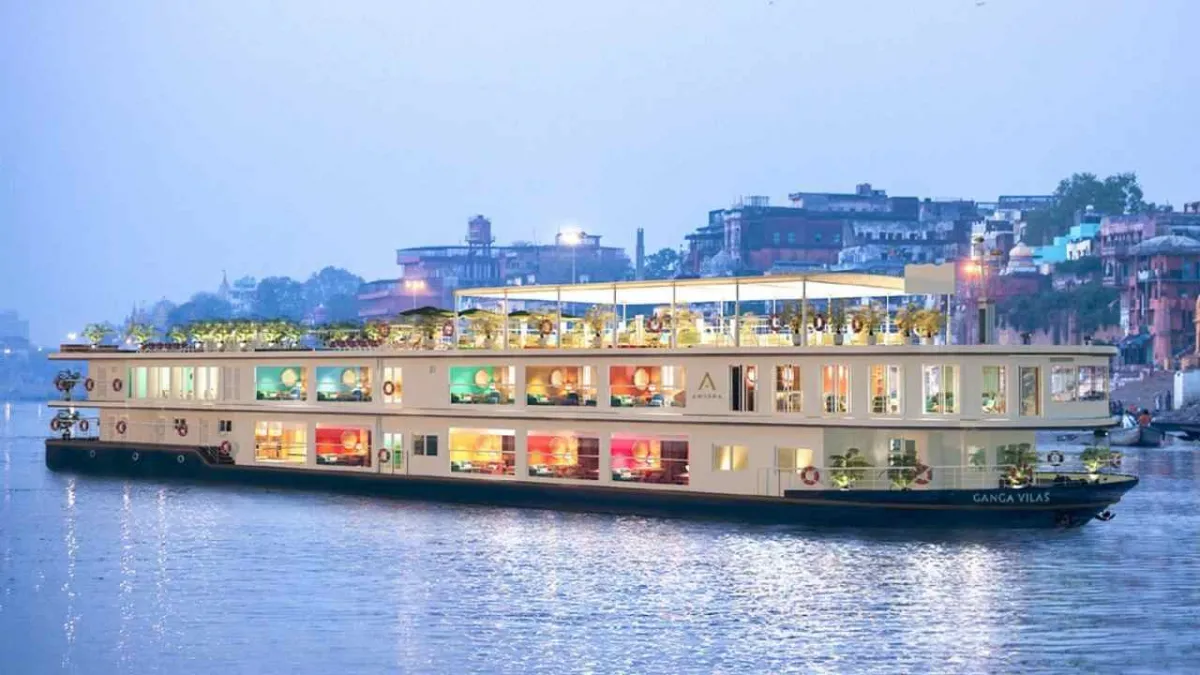New Delhi, July 10. On the sacred occasion of Guru Purnima, scenes of devotion and faith emerged from across the country. Whether it was the banks of the Sarayu in Ayodhya, the Triveni Sangam in Prayagraj, or the ghats of the Ganga in Kashi, devotees gathered everywhere. Through bathing, worship, and reverence for their gurus, people expressed their devotion.
This year, Guru Purnima in Ayodhya was celebrated with grandeur and historical significance. Devotees began assembling at the sacred ghats of the Sarayu River as early as the Brahma Muhurta. Men, women, and children took ritual baths, seeking blessings from Mother Sarayu, before visiting monasteries and temples to receive blessings from their gurus. Chants of “Har Har Mahadev” and “Jai Guru Dev” echoed everywhere.
In Prayagraj, a sea of devotees gathered at the Triveni Sangam on Guru Purnima. Pilgrims from across the country took holy dips at the confluence of the Ganga, Yamuna, and the unseen Saraswati, earning spiritual merit. After bathing, many offered donations before heading to monasteries and saints. Security arrangements were robust, with police and volunteers stationed at the ghats.
A devotee, Rakesh Kumar Tripathi, shared that he took a dip in the Ganga, sought blessings, and offered donations to priests before proceeding to seek blessings from saints and attending spiritual discourses. Another devotee remarked that Guru Purnima is a day of spiritual awakening, emphasizing the guru’s role in guiding one toward the divine.
Priest Gopal Das explained that Guru Purnima celebrates the glory of the guru, who shows the path to God.
Beyond Ayodhya and Prayagraj, Varanasi’s Dashashwamedh Ghat saw large crowds since morning. Despite rising water levels submerging steps, devotees bathed safely, offering prayers to the sun and the Ganga. Authorities, including NDRF and water police, ensured safety. After bathing, many headed to seek blessings at Kashi Vishwanath Temple.
Jay Ram Patel from Vidisha, Madhya Pradesh, shared that he came for a Ganga bath on Guru Purnima before visiting Kashi Vishwanath. Kamlesh Mishra added that Kashi’s significance is indescribable, expressing gratitude for the opportunity to bathe there.
Ayodhya
Ayodhya is an ancient city in India, revered as the birthplace of Lord Rama, a major deity in Hinduism. It holds immense religious significance and is home to the newly constructed Ram Mandir, built at the site believed to be Rama’s birthplace, following a long-standing historical and legal dispute. The city has been a pilgrimage destination for centuries and features prominently in the Hindu epic, the Ramayana.
Prayagraj
Prayagraj, formerly known as Allahabad, is a historic city in Uttar Pradesh, India, situated at the confluence of the sacred rivers Ganga, Yamuna, and the mythical Sarasvati. It is one of Hinduism’s holiest sites, hosting the Kumbh Mela, a major pilgrimage festival held every 12 years. With a rich history dating back to ancient times, Prayagraj has been a significant cultural and religious center, mentioned in Vedic texts and later serving as an important Mughal and British colonial administrative hub.
Varanasi
Varanasi, one of the world’s oldest continuously inhabited cities, is a sacred Hindu pilgrimage site located on the banks of the Ganges River in India. With a history dating back over 3,000 years, it is renowned for its ghats (riverfront steps), where devotees perform rituals, and its association with spirituality, yoga, and classical culture. The city is also home to the Kashi Vishwanath Temple, dedicated to Lord Shiva, making it a major center of religious and cultural heritage.
Sarayu
The Sarayu is a sacred river in northern India, prominently mentioned in ancient Hindu texts like the Vedas and the Ramayana. It flows through the city of Ayodhya, believed to be the birthplace of Lord Rama, and holds deep spiritual significance for Hindus. Historically, its banks have been a center of pilgrimage and cultural rituals for centuries.
Triveni Sangam
Triveni Sangam is a sacred confluence of three rivers—the Ganges, Yamuna, and the mythical Saraswati—located in Prayagraj (formerly Allahabad), India. It holds immense religious significance in Hinduism, believed to purify sins and grant spiritual liberation. The site is also famous for hosting the Kumbh Mela, the world’s largest religious gathering, every 12 years.
Ganga
The Ganga (or Ganges) is a sacred river in northern India, deeply revered in Hinduism as the goddess Ganga. It originates in the Himalayas and flows over 2,500 km before emptying into the Bay of Bengal. For centuries, it has been a center of spiritual rituals, pilgrimage, and cultural life, though it faces severe pollution challenges today.
Kashi
Kashi, also known as Varanasi, is one of the oldest continuously inhabited cities in the world and a sacred spiritual hub in Hinduism. Located on the banks of the Ganges River in India, it is believed to have been founded over 3,000 years ago and is renowned for its ghats, temples, and role as a center for learning and pilgrimage. The city is deeply associated with Lord Shiva and is considered a place where devotees attain liberation (moksha).
Dashashwamedh Ghat
Dashashwamedh Ghat, one of the oldest and most vibrant ghats in Varanasi, India, is a sacred Hindu site along the Ganges River. According to legend, it was created by Lord Brahma to welcome Lord Shiva, and its name derives from the ancient “Dasa Ashwamedha” (ten-horse) sacrifice said to have been performed here. Today, it is famous for its daily Ganga Aarti ceremony, drawing pilgrims and tourists alike.
Kashi Vishwanath Temple
The Kashi Vishwanath Temple, located in Varanasi, Uttar Pradesh, is one of India’s most sacred Hindu temples, dedicated to Lord Shiva. Believed to have been originally built in ancient times, the current structure dates to the 18th century, commissioned by Queen Ahilyabai Holkar of Indore after repeated destruction by Mughal rulers. It stands near the Ganges River and is a major pilgrimage site, symbolizing spiritual liberation in Hinduism.






